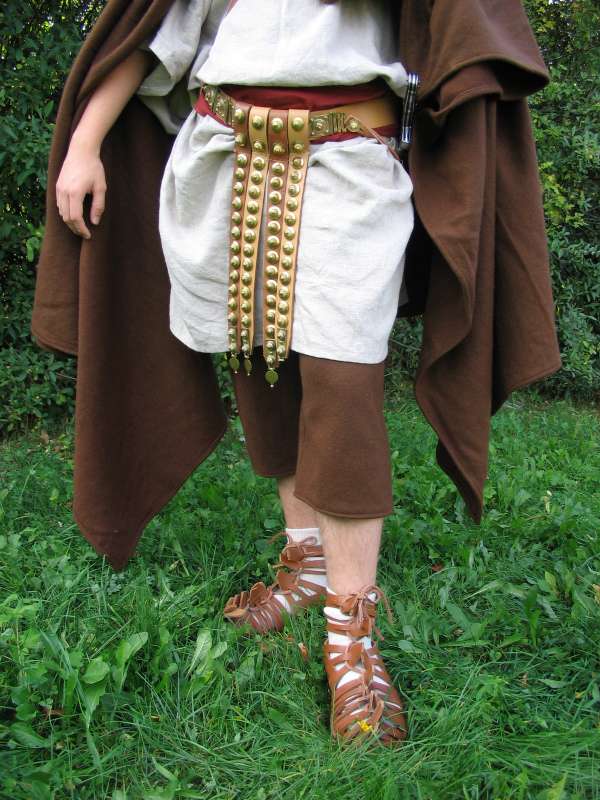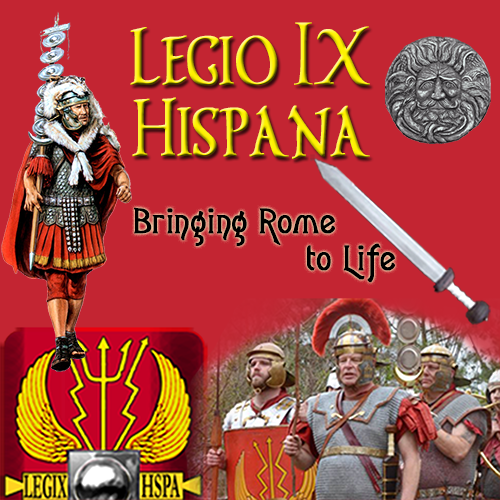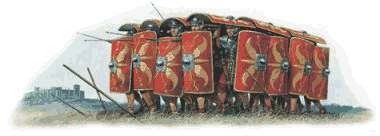Braccae (Calf-length pants)
 Both long and short
trousers were known as bracae. In illustrations they are tight-fitting and reach to just below the
knee. Modern writers often describe them as being made of leather, one example has been found at a Roman
site. Several pairs in wool have been found in Danish bogs. They are quite complex and some have belt loops.
A simpler pattern with a drawstring waist may also be used (but a belt is more comfortable
).
Both long and short
trousers were known as bracae. In illustrations they are tight-fitting and reach to just below the
knee. Modern writers often describe them as being made of leather, one example has been found at a Roman
site. Several pairs in wool have been found in Danish bogs. They are quite complex and some have belt loops.
A simpler pattern with a drawstring waist may also be used (but a belt is more comfortable
).
Thoughts on Bracae and the cold
In Caesar's day bracae were considered effeminate and barbarian-wear — something to avoided by civilized Roman men. It's cold in Britannia... obviously soldiers are not going to go around freezing or miserable.
 I got some info off of old RAT (Roman Army Talk) Older men (Augustus in
his old age, comes to mind) wore leg wrappings called fasciae crurales which are
much like modern puttees. We have found when in my cold weather kit, that simply wrapping the calves in
woollen material, thus insulating the part of the body in contact with what is normally the coldest level of air,
whilst wearing socks and a cloak seems to prevent much of my heat loss, paricularly if one has the freedom to put
your hood up. If you wear a tunic which hangs, as it should, to mid-calf when unbelted and is what I would
consider to be the minimum acceptable width of elbow to elbow. Wear a linen undertunic under this. The layering
effect allows for warm air to be trapped close to the body and the extra woollen material around the body when the
tunic is hitched up provides a good deal of insulation. Both of these effects are compounded when a cloak is
worn. I suspect that if it was really cold I would do what we know the many many Romans were in the habit of
doing: I would put a second woollen tunic on over the first. Leaving the legs above the calf bare is not
really a problem. Thanks to the tunic really only th knee and a little of the leg above it is exposed.
I got some info off of old RAT (Roman Army Talk) Older men (Augustus in
his old age, comes to mind) wore leg wrappings called fasciae crurales which are
much like modern puttees. We have found when in my cold weather kit, that simply wrapping the calves in
woollen material, thus insulating the part of the body in contact with what is normally the coldest level of air,
whilst wearing socks and a cloak seems to prevent much of my heat loss, paricularly if one has the freedom to put
your hood up. If you wear a tunic which hangs, as it should, to mid-calf when unbelted and is what I would
consider to be the minimum acceptable width of elbow to elbow. Wear a linen undertunic under this. The layering
effect allows for warm air to be trapped close to the body and the extra woollen material around the body when the
tunic is hitched up provides a good deal of insulation. Both of these effects are compounded when a cloak is
worn. I suspect that if it was really cold I would do what we know the many many Romans were in the habit of
doing: I would put a second woollen tunic on over the first. Leaving the legs above the calf bare is not
really a problem. Thanks to the tunic really only th knee and a little of the leg above it is exposed.
A.T. Croom writes that the wrappings are the later style, while first-century fashions went for a single rectangular piece of cloth going round the lower leg and secured at the top and bottom with ties. One such item was found in Søgaards Mose in Denmark and may be Roman or sub-Roman. Kept today at Skive Museum. It is also not always clear whether the wrapping represents a cloth band or garters securing a cloth tube on the outside.
Graham Sumner wrote the following post on old RAT (Roman Army Talk): Just for the sake of clarity a textile historian told me the following:
- Leggings = the square piece of material wrapped around the leg. For example the surviving piece from Denmark.
- Leg bindings = The puttee type. The thin strips of bandage like material.
In early imperial times these were seen by some Roman writers as suitable for invalids and Augustus always
susceptible to illness wore many layers of clothing and leg bindings as well. However Galen mentions that
soldiers in his day wore them and the emperor Alexander Severus is known to have always used them. Fashion
tastes had probably changed by that date but there is a possibility that we have evidence first century
soldiers may have worn them too, after all I guess we all know it is common sense to do so at times.
Firstly some bandage like material was found at Vindolanda. Could be bandages, toilet paper or even leg
bindings.
Secondly two surviving pay accounts of cavalryman including the one found at Masada mention fascia next to
the soldiers boots in the deductions for clothing. Could be something to do with lacing for the boots or
once again leg bindings.











